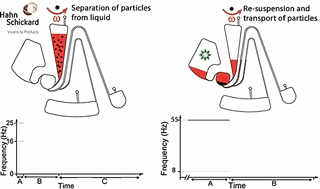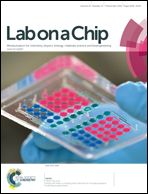Centrifugo-pneumatic sedimentation, re-suspension and transport of microparticles†
Abstract
Microparticles are widely used as solid phase for affinity-based separation. Here, we introduce a new method for automated handling of microparticles in centrifugal microfluidics that is not restricted by the particle size and requires neither auxiliary means such as magnets nor coating of microfluidic structures. All steps are initiated and controlled by the speed of rotation only. It is based on storage and “on demand” release of pneumatic energy within tunable time frames: a slow release of the pneumatic energy triggers a first fluidic path through which the supernatant above the sedimented particles is removed. An abrupt release triggers a second path which allows for liquid routing and transport of the re-suspended particles. Re-suspension of particles is thereby achieved by quickly changing the speed of rotation. We demonstrate the exchange of the particle carrier medium with a supernatant removal efficiency of more than 99.5% and a particle loss below 4%. Re-suspension and subsequent transport of suspended particles show a particle loss below 7%. The method targets the automation of particle-based assays e.g. DNA extractions and immunoassays. It is compatible with monolithic integration and suitable for mass production technologies e.g. thermoforming or injection moulding.


 Please wait while we load your content...
Please wait while we load your content...